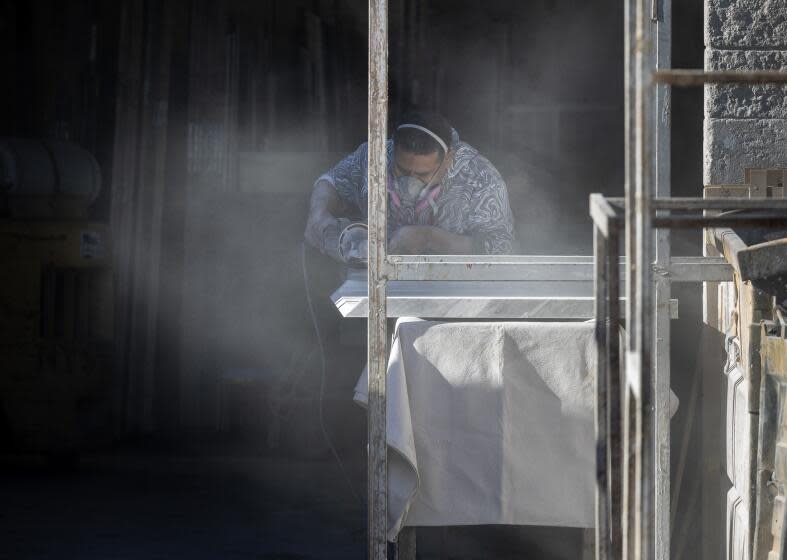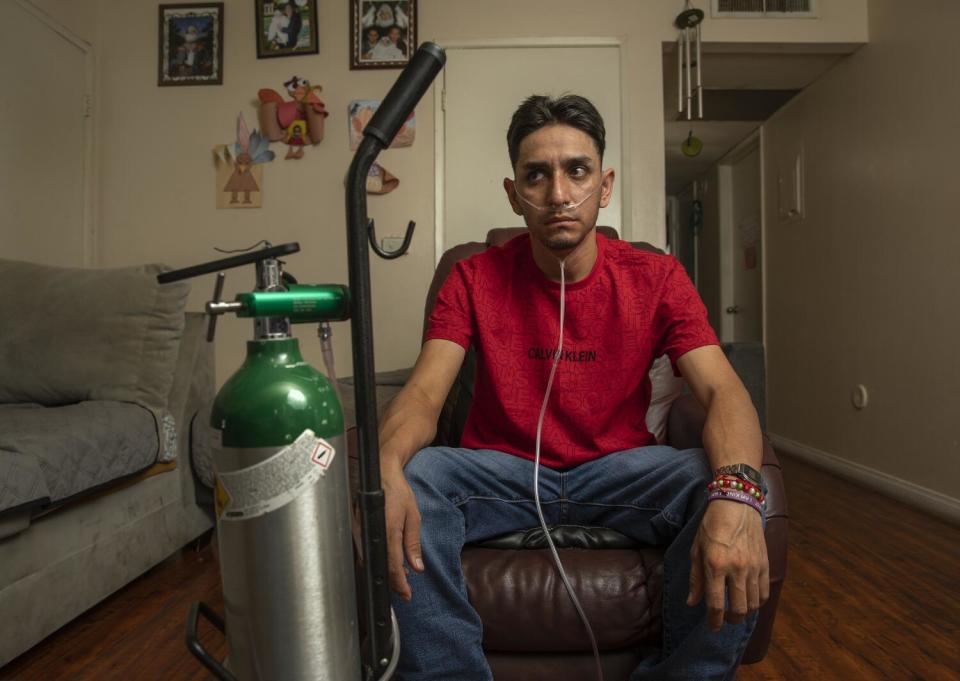California board backs rules aimed at protecting workers from deadly silicosis

California regulators voted Thursday to impose a permanent set of workplace rules aimed at protecting countertop cutters from silicosis, an incurable disease that has been killing young workers.
The unanimous vote by the California Occupational Safety and Health Standards Board extends and expands on workplace safety rules approved a year ago on an emergency basis, which are due to expire soon.
The rules are aimed at stemming the rise among workers of silicosis, which results from inhaling tiny particles of crystalline silica that scar the lungs, leaving people struggling to breathe.
"This is a devastating disease. The evidence of its cause is overwhelming, and there's something that we can do about it right now," board Chair Joseph M. Alioto Jr. said before voting for the rules.
But "I'm concerned that the regulation, in some respects, does not go far enough."
The California board also voted unanimously to convene an advisory committee to continue assessing how to strengthen the rules and implement them effectively. Alioto said the committee should also consider concerns about the rules raised by industry representatives.
Cal/OSHA estimated the expected costs of the workplace rules at $106.5 million over a decade, which the agency said would be far outstripped by the estimated benefits of $492 million from preventing illness and deaths, not counting the "indirect costs" of pain and suffering, lost wages and lost productivity.
The rules require employers to take steps to protect workers, such as providing protective respirators and using water to suppress dust, when employees are cutting, grinding or polishing slabs. They also eliminate earlier loopholes that allowed stonecutting shops to dodge safety requirements by claiming that protective steps weren't feasible, according to Cal/OSHA officials.
The agency said that in the past, state rules relied on employers to perform sophisticated assessments to decide what protections were needed. Many failed to do so, forcing the state to do the assessments itself, which could be manipulated by employers changing their usual practices when Cal/OSHA showed up, it said.
Tighter rules have empowered Cal/OSHA to act more quickly when workers were at risk, the agency said. As of early December, the state agency said it had inspected 85 stonecutting shops and issued 22 orders to temporarily shut down equipment or processes until the shops had addressed "imminent hazards" related to silica.

The rules approved Thursday require businesses to shift laborers to other kinds of work — but keep providing the same pay — if a medical professional recommends it to reduce their silica exposure. They also require more sensitive scans, rather than chest X-rays, to detect silicosis among workers who could be at risk.
Industry groups said the rule took an ineffective, "one-size-fits-all" approach. The Natural Stone Institute and the International Surface Fabricators Assn. called instead for a system they likened to "TSA pre-check." Businesses that can show silica exposure is consistently below a set level should not have to face many of the stiffer requirements that were ushered in last year, they argued.
"We're not talking about a rubber stamp," said Marissa Bankert of the International Surface Fabricators Assn., which represents businesses that cut and polish slabs. "We're talking about the development of a rigorous system that qualifies the organizations ... who are doing things correctly."
Read more: Safer stone? New countertop options emerge amid concerns over silicosis and worker deaths
Bankert said her organization doesn't want workers to fall ill, but under the tighter rules, "we're still seeing these shops that are not compliant, right? And creating more rules is not going to help those people."
In a report, Cal/OSHA staff said the rules do include some reduced requirements if employers show that silica exposure is sufficiently low, but argued against easing them further, saying, "the life of workers cannot be put at risk based on the results of air sampling, which can be highly variable from day to day."
Health officials have tied the silicosis outbreak among countertop cutters to the swelling popularity of engineered stone, which can contain upward of 93% crystalline silica. In a report, Cal/OSHA described the artificial slabs as the most popular choice for countertops in the U.S., with a market size exceeding $17 billion.
Engineered stone companies say their slabs can be cut safely with proper precautions, but Cal/OSHA said that dusty and dangerous conditions have persisted in many of the "fabrication shops" where workers cut and polish slabs to fashion them into countertops.
Experts warned that even with wet cutting, workers can be at risk. Georgia Tech scientist Jenny Houlroyd told the board Thursday that among Georgia workers cutting engineered stone high in silica, "we have not been able to consistently and effectively get companies to keep their exposures below" the limit.
Relying on wet methods and ventilation can be inadequate due to the high level of silica in the slabs, but stonecutters often have a "false sense of security" and end up removing their respirators, Houlroyd said.
Read more: Jury finds stone companies at fault in lawsuit by countertop cutter sick with silicosis
Her presentation grabbed the attention of Alioto, who said he was concerned that her data and other findings shared by Cal/OSHA staff might mean that some exceptions laid out in the rules were not scientifically sound.
Bankert of the International Surface Fabricators Assn. told the board Thursday that on the topic of wet cutting, "we have data of our own that completely contradicts that" presented during the meeting.
"Wet methods may not be the total solution, but when coupled with good housekeeping, routine monitoring, medical surveillance and so forth. ... We want to work together," Jim Hieb, chief executive of the Natural Stone Institute, told the board.
More than 200 cases of silicosis have been detected among California workers who cut countertops in recent years, including at least 15 that have led to death, according to public health officials. Men in their 20s, 30s and 40s have ended up relying on oxygen tanks or waiting for lung transplants to survive. One study of California countertop cutters with the disease found the median age among those who had died was 46.
"Workers should not be dying or needing lung transplants for the sake of our kitchen countertops," Dr. Amy Heinzerling, head of the emerging workplace hazards unit at the California Department of Public Health, told the board.
Heinzerling said the known cases could be the tip of an iceberg because additional workers might not have been screened. State officials warned that if trends don't change, as many as a fifth of the roughly 5,000 workers in stonecutting shops identified across California could develop silicosis and up to 200 could die of it.
There are also conflicting estimates of the size of the industry: California public health officials have estimated there are more than 800 stonecutting shops across the state, but an industry official said at a UCLA conference earlier this year that his group believed there were roughly 3,000 of them.

The rules approved Thursday require employers to take steps to protect workers when they are cutting or polishing slabs of engineered stone with more than 0.1% crystalline silica or natural stone with more than 10% silica.
Engineered stone has been broadly banned in Australia, and some researchers have called for other countries to prohibit artificial slabs high in silica, arguing that that is the most effective way to protect workers. When asked whether the California rules go far enough, Houlroyd told a board member that "in an ideal world, I would look to what Australia did." Several advocates spoke in favor of a ban during the Thursday meeting.
Read more: California countertop workers died of a preventable disease. The threat was known years earlier
Cal/OSHA has previously warned that if the rules are widely violated, it could take steps toward a ban. But in a report, the agency said it decided against pursuing one at this point because it "could incentivize the growth of illegal fabrication shops that are hidden from regulators" or push scofflaw shops to other states.
State Sen. Caroline Menjivar (D-Panorama City) recently proposed a certification system for stonecutting shops that would require safety training for workers, create a tracking system for shops, and bar slab manufacturers from providing their products to uncertified shops. Then-Assemblymember Luz Rivas abandoned a similar bill in July, saying that state regulators were not receptive to the idea of setting up a tracking system.
In a recent interview, Menjivar said that after a year under the emergency standards, "we are in a better place to say, 'We gave you a shot. It wasn't enough'" to state regulators. She was unimpressed by the number of workshops inspected and shut down by Cal/OSHA under the emergency rules.
"I'm sick and tired of us not having urgency when it's people of color dying," she said. "If one person died from Beverly Hills, all the alarms would go off."
This story originally appeared in Los Angeles Times.


